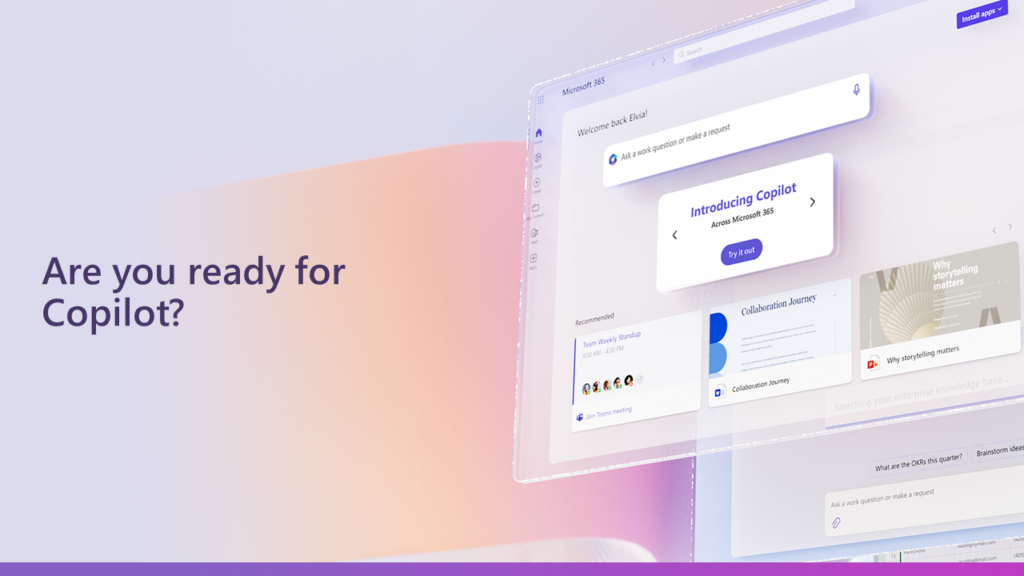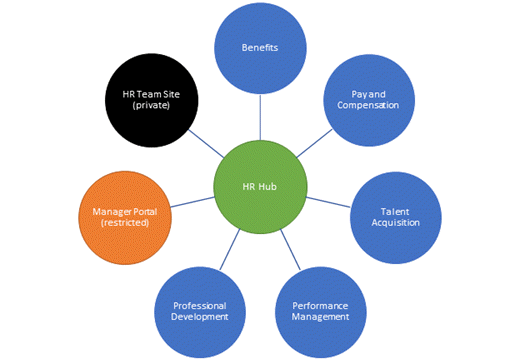Is Your Organization Ready for Copilot for Microsoft 365?
Table of Contents
Copilot for Microsoft 365 is a conversational AI assistant that can help you access and leverage information from across your organization. Copilot uses natural language to provide relevant and personalized answers to your questions and perform actions on your behalf.
Behind the scenes Copilot leverages multiple search engines and a large language model to provide natural and personalized answers to your questions. It can help you with a wide range of scenarios, such as summarizing emails, creating tickets, finding authoritative content, and more.
But how can you make sure that your organization is ready to take advantage of Copilot and get the most out of it? In this blog post, we will cover three topics that will help you prepare your organization for Copilot:
- AI readiness
- The importance of authoritative content
- How to architect your tenant for Copilot
1) AI Readiness

AI readiness is the degree to which your organization can adopt and benefit from AI technologies, such as Copilot for M365. AI readiness is important for Copilot adoption and success, as it determines the quality and relevance of the results that Copilot can provide.
One of the key factors that affects AI readiness is search optimization. Search optimization is the process of improving the findability and accessibility of content across the organization. Search optimization is critical for Copilot, as it enables Copilot to access and consume high-quality and comprehensive content from various sources.
Copilot uses different search engines to provide answers to user queries, such as Microsoft Graph, semantic search, and large language model.
- Microsoft Graph is a data fabric that connects data and insights across Microsoft 365 and other systems.
- Semantic search is the ability to understand the meaning and intent of user queries and content. Semantic search has two parts; a tenant-wide index that covers all content shared with everyone in the organization and a personalized index that covers individual’s email, conversations, chats, documents, and other private information.
- Large language model is the AI system that can generate natural language responses based on user queries and content.
These search engines work together to understand the intent and context of user queries and provide the best possible results.
For example, if a user asks Copilot to summarize an email, Copilot will use Microsoft Graph to access the email content, semantic search to extract the main points, and large language model to generate a concise summary.
This means to get the most value from Copilot you need to optimize your current Microsoft 365 tenant in two ways:
- Increasing the amount of authoritative content in your organization
- Better architecting your environment for search
Want Help on Your Journey?
Our free two-hour Microsoft Copilot for M365 readiness briefing ensures your organization is prepared to take advantage of Copilot.
2) Increasing the Amount of Authoritative Content
Authoritative content is the content that is trusted and verified by the organization as the source of truth for a given topic or domain. Authoritative content can enhance the Copilot experience and trust, as it ensures that the answers that Copilot provides are accurate and reliable.
A fundamental way to increase Copilot’s value is to enable as much authoritative content as possible to be searched by Copilot.
Copilot’s capabilities are not limited to the content and functionality available in Microsoft 365. You can extend Copilot with connectors and plugins to access and interact with data and systems that reside outside of Microsoft 365.
Understanding Connectors and Plugins
- Connectors are components that allow Copilot to read data from external sources, such as databases, third-party applications, or web services. For example, a connector can enable Copilot to query your IT ticketing system or your CRM system for customer information. Connectors can enhance Copilot’s search results by providing additional and relevant information from various sources.
- Plugins are components that allow Copilot to write data or perform actions on external systems, such as creating, updating, or deleting records, sending messages, or launching workflows. For example, a plugin can enable Copilot to create a new support ticket, update a customer account in your CRM system, or send an email.
Plugins can enhance Copilot’s functionality by enabling users to complete tasks without leaving the Copilot conversation. This is where Copilot will truly revolutionize work for everyone. You can complete a multi-step process within a Copilot conversation.
Connectors and plugins are available in many places, such as search optimization, custom applications, or Copilot Studio. Users can choose from existing connectors and plugins or create their own using the Copilot SDK. Users can also publish their custom applications to the Copilot environment, so that Copilot can direct users to the appropriate application based on their intent.
By extending Copilot with connectors and plugins, users can leverage Copilot as a single interface to access and interact with a wide range of data and systems across the organization. This can improve user productivity, efficiency, and satisfaction. To dive deeper on how these tools create a unified workflow, check out our blog on How Copilot Works Behind the Scenes.
Creating Authoritative Content within Microsoft 365
One of the ways to create and manage authoritative conthttp://: https://lanternstudios.com/insights/blog/how-copilot-work…ehind-the-scenes/ent within Microsoft 365 is to use Viva Topics. Viva Topics is a service that automatically identifies, organizes, and delivers topic pages and related content across the organization. Topic pages are web pages that provide a comprehensive overview of a specific topic, such as a project, a product, or a concept. Topic pages can include information such as definitions, descriptions, images, videos, documents, experts, and more.
Viva Topics can help define and surface authoritative content across the organization, as it allows users to:
- Discover and access topic pages from various sources, such as SharePoint, Outlook, Teams, and Copilot.
- Edit and curate topic pages to ensure that they are accurate and complete.
- Create and publish new topic pages to share knowledge and expertise with others.
- Connect and collaborate with topic experts and peers to learn and exchange ideas.
Copilot can consume and process authoritative content from different sources and return natural and personalized results. For example, if a user asks Copilot to find the latest sales report, Copilot will use semantic search to find the most relevant and authoritative document from SharePoint, use large language model to generate a summary of the document, and use Microsoft Graph to display the document metadata and link.
3) Architecting Your Environment for Search
Architecting your environment for Copilot is the process of designing and configuring the collaboration and security environment for Copilot to access and share the right content with the right users. Architecting your environment for Copilot is important, as it ensures that Copilot respects the security and privacy of content and users while providing useful and actionable information.
A best practice is to structure your data in a clear and consistent manner. One of the ways to do that is to use Modern SharePoint team sites with a hub and spoke architecture. The hub and spoke architecture is a model that consists of a central hub site and multiple associated spoke sites. The hub site is the main site that provides common navigation, branding, and search scope for the spoke sites. The spoke sites are the individual sites that host and manage specific content and functionality for the hub site.

The hub and spoke architecture can help Copilot understand the intent of the queries and return the most appropriate results. The hub and spoke architecture allow users to:
- Create and join hub sites and spoke sites based on the content type and purpose, such as department, project, team, etc.
- Share and discover content across the hub site and spoke sites using the common navigation and search scope.
Control Visibility and Availability of Content
Another aspect of architecting the environment for Copilot is to control the visibility and availability of content for Copilot. One of the ways to do that is to use sensitivity labels and all company access.
- Sensitivity labels are labels that can be applied to content and containers to classify and protect them based on the level of confidentiality and sensitivity. With sensitivity labels you can specify the level of protection and restriction, such as public, internal, confidential, etc.
- To get the most value from Copilot you want to ensure content that is relevant across the organization is shared with everyone in the organization. All company access is a setting that can be applied to content and containers to make them visible and available to all users in the organization.
- Lastly, you can apply retention policies to content so old and outdated data can be removed from the system. This will enable Copilot to return the most current and accurate information.
Copilot respects the security and privacy of content and users while providing useful and actionable information. For example, if a user asks Copilot to find a confidential document, Copilot will use Microsoft Graph to check the sensitivity label and the permissions of the document, and only return the document if the user has the appropriate access and clearance.
Ready to deploy Copilot for Microsoft 365?
Contact us to see how we can help you move forward quickly.
Conclusion and Final Thoughts
The need for search optimization only grows in importance when you deploy Copilot for Microsoft 365. You are going to be relying on Copilots to do your job, and most users will simply trust the results in Copilot are accurate and comprehensive without realizing they might not be accessing the latest information, or the highest quality (authoritative) data.
In this blog post, we have covered three main topics that can help you prepare your organization for Copilot: AI readiness, authoritative content, and architecting the environment for Copilot. These topics can help you optimize the search, enhance the trust, and secure the content for Copilot, and ultimately, get the most out of Copilot.
